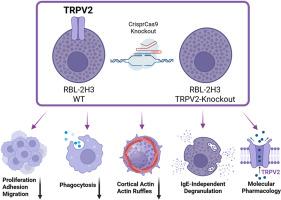遗传和药理学证据表明离子通道TRPV2在大鼠嗜碱性白血病细胞中作为肌动蛋白依赖功能性状的调节剂。
IF 4.7
3区 医学
Q1 PHARMACOLOGY & PHARMACY
引用次数: 0
摘要
瞬时受体电位离子通道TRPV2在源自造血干细胞的细胞中广泛表达,对有效的先天免疫至关重要。TRPV2在肥大细胞中表达,在肥大细胞中,物理刺激激活TRPV2引起体制性荨麻疹。由于目前只有非选择性的药理学工具可用于研究TRPV2,因此肥大细胞中TRPV2的功能表征仍然不精确。我们研究了在crispr - cas9基因缺失TRPV2后的肥大细胞样大鼠嗜碱性白血病(RBL-2H3)细胞。缺乏TRPV2的细胞不能产生非选择性TRPV2激动剂2-氨基乙氧基二苯硼酸酯(2-APB)和probenecid (PBC)诱导的膜电流,细胞增殖、细胞粘附、迁移和吞噬能力降低。转化生长因子β1 (TGF-β1)在野生型RBL2-2H3细胞中降低皮质肌动蛋白,而在trpv2敲除细胞中,皮质肌动蛋白的基础水平降低,但TGF-β1不改变。TRPV2的缺失减少了TGF-β1诱导的膜褶的数量,并在未刺激和TGF-β1处理的细胞中增加磷酸化的ERK (p-ERK)。IgE抗原刺激FcεRI受体诱导β-己糖氨酸酶释放不依赖于TRPV2。PBC单独应用或与2-APB,大麻二酚(CBD)或质子联合诱导trpv2依赖性脱粒。细胞内残基His165和His521对大鼠TRPV2的ph敏感激活至关重要。我们的数据表明,TRPV2调节RBL2-2H3细胞的肌动蛋白依赖性肥大细胞样特性。PBC可以作为诱导TRPV2依赖但ige不依赖的脱颗粒的药理学工具,它采用一种新的分子机制,以质子依赖的方式激活TRPV2。本文章由计算机程序翻译,如有差异,请以英文原文为准。

Genetic and pharmacological evidence for a role of the ion channel TRPV2 as a regulator of actin-dependent functional traits in rat basophilic leukemia cells
The transient receptor potential ion channel TRPV2 is broadly expressed in cells originating from hematopoietic stem cells and is vital for an effective innate immunity. TRPV2 is expressed in mast cells, where it was suggested that physical stimuli activate TRPV2 to provoke physical urticaria. Given that only unselective pharmacological tools are available to study TRPV2, functional characterization of TRPV2 in mast cells remains imprecise. We studied mast cell-like rat basophilic leukemia (RBL-2H3) cells following CRISPR-Cas9-genetic deletion of TRPV2. Cells lacking TRPV2 fail to generate membrane currents induced by the nonselective TRPV-agonists 2-aminoethoxydiphenyl borate (2-APB) and probenecid (PBC), and they exhibit reduced proliferation, cell adhesion, migration and phagocytosis. While Transforming Growth Factor β1 (TGF-β1) reduces cortical actin in wildtype RBL2-2H3 cells, the basal level of cortical actin is reduced in TRPV2-knockout cells but not modified by TGF-β1. Deletion of TRPV2 reduces the numbers of membrane ruffles induced by TGF-β1, and it increases phosphorylated ERK (p-ERK) in both unstimulated and TGF-β1-treated cells. The release of β-hexosaminidase induced by IgE antigen-stimulation of FcεRI receptors does not depend on TRPV2. PBC applied alone or in combination with 2-APB, cannabidiol (CBD), or protons induce a TRPV2-dependent degranulation. The intracellular residues His165 and His521 are crucial for this pH-sensitive activation of rat TRPV2. Our data suggest that TRPV2 regulates actin-dependent mast cell-like properties of RBL2-2H3 cells. PBC can be used as a pharmacological tool to induce a TRPV2-dependent but IgE-independent degranulation, and it employs a novel molecular mechanism to activate TRPV2 in a proton-dependent manner.
求助全文
通过发布文献求助,成功后即可免费获取论文全文。
去求助
来源期刊
CiteScore
9.00
自引率
0.00%
发文量
572
审稿时长
34 days
期刊介绍:
The European Journal of Pharmacology publishes research papers covering all aspects of experimental pharmacology with focus on the mechanism of action of structurally identified compounds affecting biological systems.
The scope includes:
Behavioural pharmacology
Neuropharmacology and analgesia
Cardiovascular pharmacology
Pulmonary, gastrointestinal and urogenital pharmacology
Endocrine pharmacology
Immunopharmacology and inflammation
Molecular and cellular pharmacology
Regenerative pharmacology
Biologicals and biotherapeutics
Translational pharmacology
Nutriceutical pharmacology.

 求助内容:
求助内容: 应助结果提醒方式:
应助结果提醒方式:


